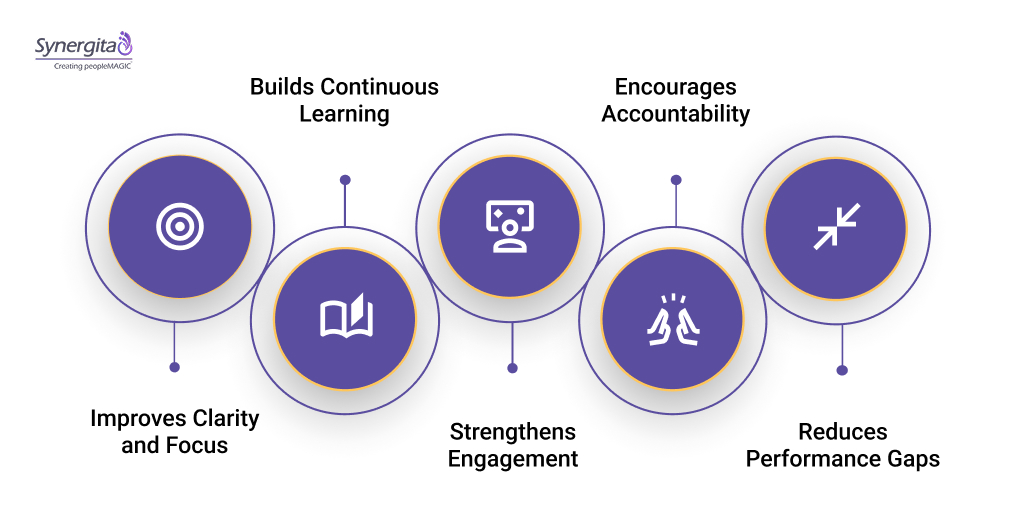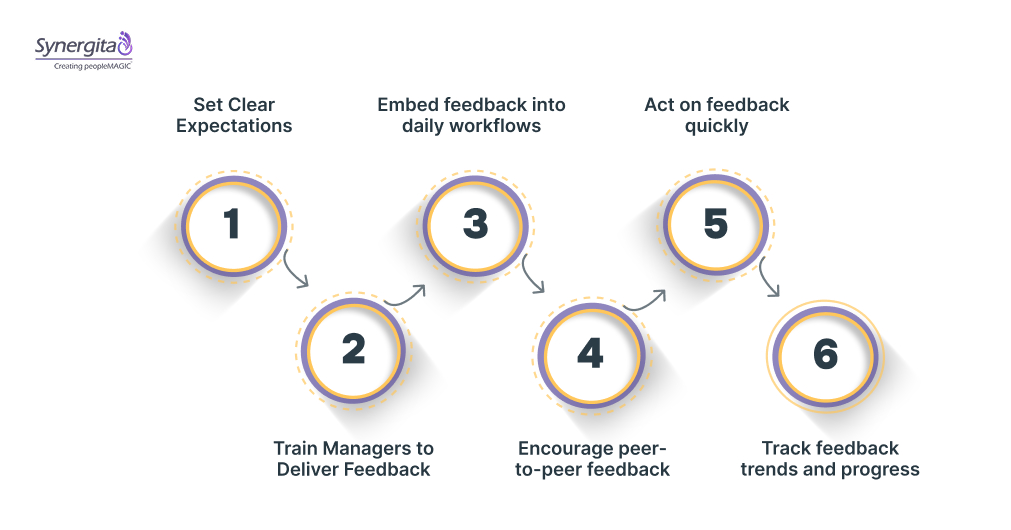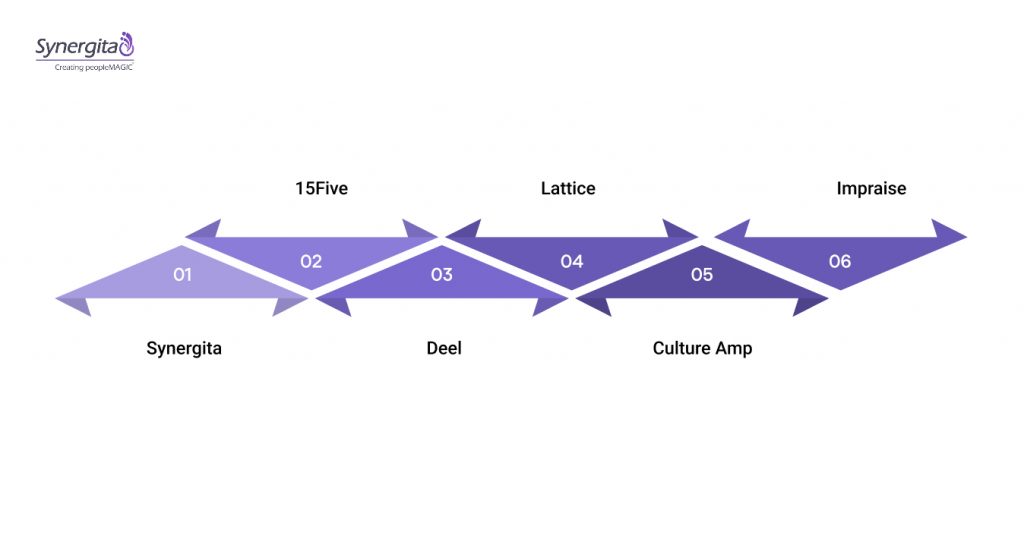Annual reviews used to be the backbone of employee performance management. But today’s work environment moves too fast. Waiting months to give feedback means missed opportunities for improvement and alignment.
In fact, Gallup found that 80% of employees who received meaningful feedback in the past week report being fully engaged.
That’s the power of real-time employee feedback. It brings performance conversations into the flow of work, allowing managers to recognize effort, course correct quickly, and support growth as it happens. Feedback becomes a live tool for improvement, motivation, and accountability.
In this blog, we explore how real-time feedback drives performance, engagement, and continuous learning.
At a glance:
- Real-time employee feedback turns performance conversations into immediate coaching opportunities, helping employees adjust and improve quickly.
- Ongoing feedback strengthens clarity, focus, and engagement by connecting actions to outcomes and reinforcing expectations.
- Continuous feedback fosters a learning culture, allowing employees to develop skills and grow without waiting for annual reviews.
- Timely input encourages accountability, makes progress measurable, and reduces long-term performance gaps.
- The right tools make giving, receiving, and tracking feedback seamless, enabling teams to stay productive, motivated, and aligned with organizational goals.
What Is Real-Time Employee Feedback?
Real-time employee feedback means sharing employee performance input instantly—while the context and details are still fresh. Instead of waiting for quarterly reviews, managers and peers address wins and challenges as they happen.
For example, a sales manager can message a rep right after a client call to acknowledge how they handled objections or suggest ways to refine their pitch. That kind of immediacy turns feedback into a coaching moment, not a delayed critique.
Unlike traditional feedback, which often feels backward-looking and tied to evaluation, real-time feedback keeps performance conversations ongoing. It builds trust, clarifies expectations, and helps employees make quick, meaningful adjustments that drive better results.
How Real-Time Feedback Enhances Employee Performance
Timely feedback creates a stronger connection between actions and outcomes. When employees know what they did well—or what needs adjustment—immediately, they can course-correct and improve faster.

Here’s how it enhances performance across the board:
- Improves Clarity and Focus: Instant feedback reinforces what’s expected, helping employees prioritize the right goals and behaviors in real time. It ensures that effort is consistently aligned with organizational objectives.
- Builds Continuous Learning: Frequent, bite-sized feedback turns daily work into a learning loop, encouraging growth instead of waiting for annual evaluations. Over time, this fosters a culture where improvement feels natural and ongoing.
- Strengthens Engagement: When employees receive acknowledgment or guidance quickly, they feel seen and supported, driving higher motivation and commitment. It builds trust and strengthens the bond between employees and their managers.
- Encourages Accountability: Real-time input makes progress visible and measurable, helping individuals take ownership of outcomes and track improvement. Employees begin to self-assess and proactively seek feedback to perform better.
- Reduces Performance Gaps: Managers can identify and resolve issues early, preventing small mistakes from turning into long-term problems. This proactive approach improves overall team performance and reduces the need for corrective interventions later.
Together, these benefits create a culture of responsiveness and improvement, where performance management becomes a continuous process rather than an occasional review.
Also read: 15 Effective Feedback Models: Definition and Examples
How to Implement a Real-Time Feedback Culture: A Step-by-Step Guide
Building a real-time feedback culture takes more than introducing new tools. It requires a mindset shift where feedback becomes an everyday practice instead of a scheduled formality. The goal is to create an environment where conversations about employee performance and growth happen naturally, not just during annual reviews.

Here’s how to make that transition effectively:
1. Set Clear Expectations
Begin by defining what real-time feedback looks like in your organization. Explain how it differs from traditional feedback: short, focused, and tied to specific actions or behaviors. Employees should know when and how to give feedback, and managers must understand that it is meant to guide improvement, not assign blame.
For example, instead of saying “You need to improve your reports,” a manager might say, “Your report today was thorough. Adding a short executive summary next time will make it even clearer.”
2. Train Managers to Deliver Feedback Constructively
Managers play a key role in shaping how feedback is received. Offer short training sessions on giving actionable, balanced feedback that focuses on facts rather than assumptions. Encourage them to follow the SBI model (Situation, Behavior, Impact), which helps frame feedback objectively.
For instance, “In yesterday’s meeting (Situation), you interrupted a colleague twice (Behavior), which made it hard for others to share ideas (Impact).”
3. Embed feedback into daily workflows
Feedback should not feel like an extra task. Integrate it into existing communication channels.
Tools like Synergita or Slack-integrated feedback systems allow teams to share quick notes of appreciation or constructive comments in real time. When feedback is woven into daily work, it becomes part of the rhythm rather than a disruption.
4. Encourage peer-to-peer feedback
Real-time feedback should not flow only from manager to employee. Encourage team members to recognize each other’s efforts, share quick pointers, or celebrate wins.
This helps strengthen collaboration and builds psychological safety. People feel more comfortable giving and receiving input when it is normalized across all levels.
5. Act on feedback quickly
Nothing kills a feedback culture faster than inaction. When feedback is shared, follow up promptly. If an employee suggests a process improvement, acknowledge it and act where possible.
Similarly, when managers give feedback, they should check in later to discuss progress. This closes the loop and reinforces that feedback drives real outcomes.
6. Track feedback trends and progress
Use HR or performance management tools to track how feedback is being used. Look for participation rates, response times, and qualitative patterns.
- Are employees acting on feedback?
- Are managers engaging regularly?
These insights help refine your strategy and highlight where coaching may be needed.
Creating a real-time feedback culture takes time, but once it becomes part of daily practice, it improves communication, accountability, and engagement across the organization.
Common Challenges in Building a Real-Time Feedback Culture
While real-time feedback can transform employee performance and engagement, it also comes with its own set of challenges. Recognizing these early helps organizations build systems that actually work in practice.
- Inconsistent Feedback Habits: Not all managers or teams share feedback regularly. Some may avoid it altogether, while others overdo it. Without consistency, employees get mixed signals about what matters.
- Fear of Negative Feedback: Employees may associate feedback with criticism, making them defensive or disengaged. This can discourage open communication.
- Lack of Time: In busy teams, feedback often takes a backseat to daily operations. When feedback is delayed, it loses impact.
- Poor Feedback Quality: Generic or vague feedback (“good job” or “needs improvement”) adds little value. Employees don’t know what to repeat or change.
- Limited Follow-Through: When feedback doesn’t lead to visible change, employees stop valuing it.
To make real-time feedback a daily habit, teams need the right tools that simplify sharing input and make feedback continuous, visible, and actionable across the organization.
Top 5 Tools for Real-Time Employee Feedback
Choosing the right tool is key to embedding a culture of continuous feedback. The right platform makes giving, receiving, and tracking feedback seamless, helping employees improve performance and stay engaged.

Here are five tools that stand out in 2025:
1. Synergita
Synergita is an all-in-one performance management and employee engagement platform that helps organizations track goals, monitor performance, and foster a growth-oriented culture. It combines real-time dashboards, continuous feedback, and AI-driven insights to give leaders clear visibility into workforce trends.
Key Features:
- Goal Setting and Tracking: Define SMART goals, align them across teams and departments, and monitor real-time progress to ensure everyone stays focused on what matters most.
- Continuous Feedback: Managers and peers can provide ongoing feedback, coaching, and recognition to accelerate learning and keep performance on track.
- 360-Degree Feedback: Collect comprehensive performance insights from peers, managers, and direct reports to identify strengths, skill gaps, and development opportunities.
- AI-Powered Sentiment Analysis: Analyze employee feedback and engagement data using natural language processing to gauge morale, emotions, and organizational culture.
- Customizable Dashboards and Reports: Visualize KPIs and performance metrics in a way that makes sense for your organization, helping leaders make informed, data-driven decisions.
Synergita helps organizations connect performance management with employee engagement, creating a transparent, accountable, and growth-focused workplace.
Also read: Easy 360 Degree Appraisal Sample You Can Start Using Today
2. 15Five
15Five focuses on weekly check-ins and real-time feedback, helping managers catch issues early and recognize achievements as they happen.
Key Features:
- Weekly Check-ins: Simple prompts to share wins, challenges, and feedback.
- Recognition Tools: Celebrate achievements instantly.
- Performance Analytics: Track team engagement and progress over time.
3. Deel
Deel goes beyond payroll and compliance, offering insights into employee engagement and performance. It helps managers provide timely feedback across distributed teams while keeping workforce data centralized.
Key Features:
- Real-Time Feedback: Share and track performance updates instantly.
- Global Workforce Insights: Monitor trends and engagement across regions.
- Integration with HR Systems: Consolidate feedback, payroll, and HR data for actionable insights.
4. Lattice
Lattice blends performance reviews, real-time feedback, and one-on-one meeting tools. It makes feedback a natural, ongoing conversation rather than a periodic event.
Key Features:
- Real-Time Feedback: Submit and receive feedback continuously.
- Peer Recognition: Boost engagement with team-wide acknowledgment.
- Insights & Reporting: Spot patterns and measure development impact.
5. Culture Amp
Culture Amp emphasizes employee engagement and development, using feedback data to guide performance improvement and retention strategies.
Key Features:
- Continuous Feedback: Gather input from managers and peers in real time.
- Surveys & Pulse Checks: Measure engagement and sentiment frequently.
- Analytics Dashboard: Identify trends and skill gaps to guide interventions.
Also read: Lattice vs Culture Amp: Which HR Platform Fits Your Team in 2025?
6. Impraise
Impraise supports on-the-go feedback with mobile and web apps, making it easy to comment, praise, or suggest improvements instantly.
Key Features:
- Mobile Feedback: Give and receive feedback anytime, anywhere.
- Goal Tracking: Align feedback with objectives and performance metrics.
- Performance Insights: Track progress and measure outcomes across teams.
Each feedback tool offers features such as continuous feedback, performance tracking, sentiment analysis, and goal alignment, helping teams stay engaged and productive.
When choosing a real-time feedback solution, prioritize platforms that seamlessly integrate with your existing workflows, support continuous performance tracking, and provide actionable insights to drive engagement, growth, and measurable employee outcomes.
Wrapping Up
Real-time employee feedback is essential for improving performance, engagement, and team alignment. By providing timely, actionable insights, organizations can help employees course-correct, celebrate wins, and continuously grow.
Unlike traditional annual reviews, ongoing feedback creates a culture of learning, accountability, and motivation, ensuring teams stay productive and focused on goals.
Platforms like Synergita simplify this process by combining continuous feedback, goal tracking, 360-degree evaluations, and AI-driven sentiment analysis into a single, intuitive system. With real-time dashboards and actionable insights, managers can make informed decisions while employees feel recognized and supported.
Book a demo with Synergita today to foster a performance-driven, growth-oriented workplace.
FAQs
1. What Are the Benefits of Real-Time Employee Feedback?
It boosts engagement, accelerates learning, reduces errors, strengthens communication, and helps employees align with goals, creating a culture of continuous improvement and higher performance.
2. What is an Example of Real-Time Feedback?
Real-time feedback occurs when a manager immediately acknowledges an employee’s work, such as praising a well-written report or suggesting corrections during a project, helping them improve instantly.
3. How to Give Real-Time Feedback?
Provide feedback promptly after the observed behavior, focus on specific actions, balance positive and constructive points, and use a supportive tone to encourage improvement and learning.
4. What is a Real-Time Feedback System?
It is a platform that allows continuous performance monitoring, instant feedback, and engagement tracking, enabling managers and peers to address issues, recognize achievements, and support employee growth immediately.
5. What Are the Challenges of Implementing Real-Time Feedback?
Common challenges include manager hesitation, inconsistent usage, feedback overload, and lack of training, which can reduce effectiveness if not addressed with clear guidelines and support.
6. What is an Example of Good Employee Feedback?
Good feedback is specific, actionable, and timely, such as “Your presentation was clear and persuasive; consider adding more visuals next time to enhance audience engagement.”



